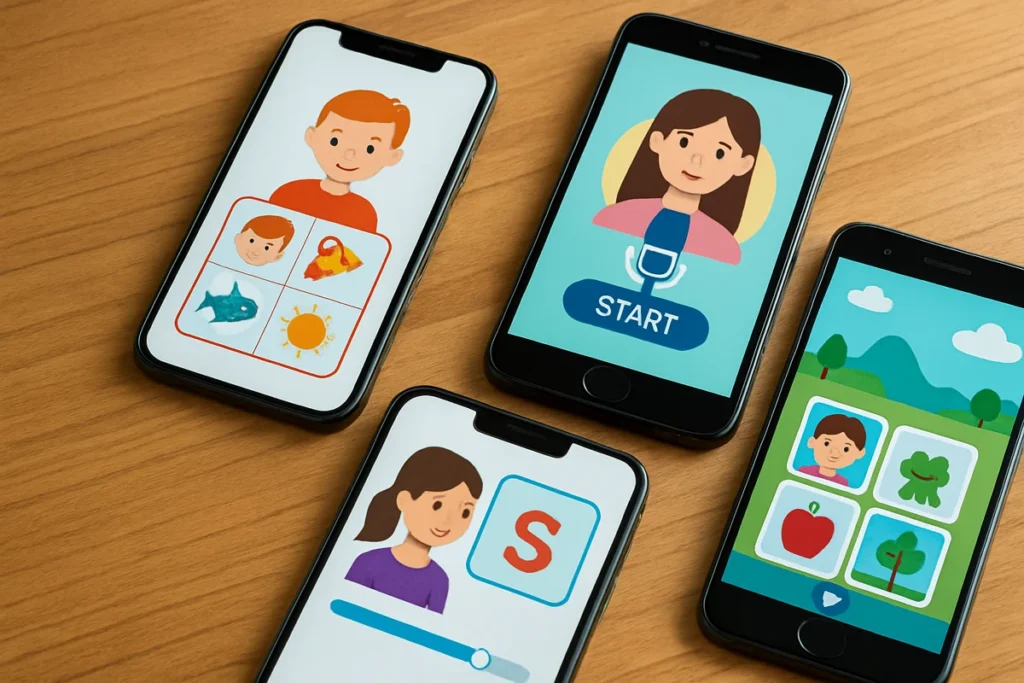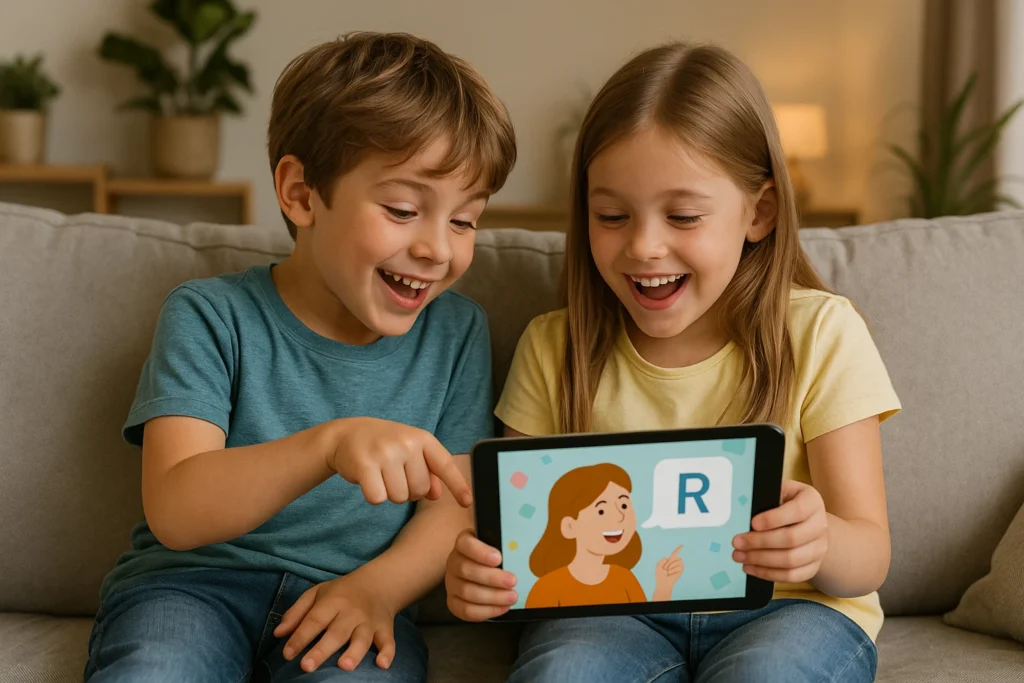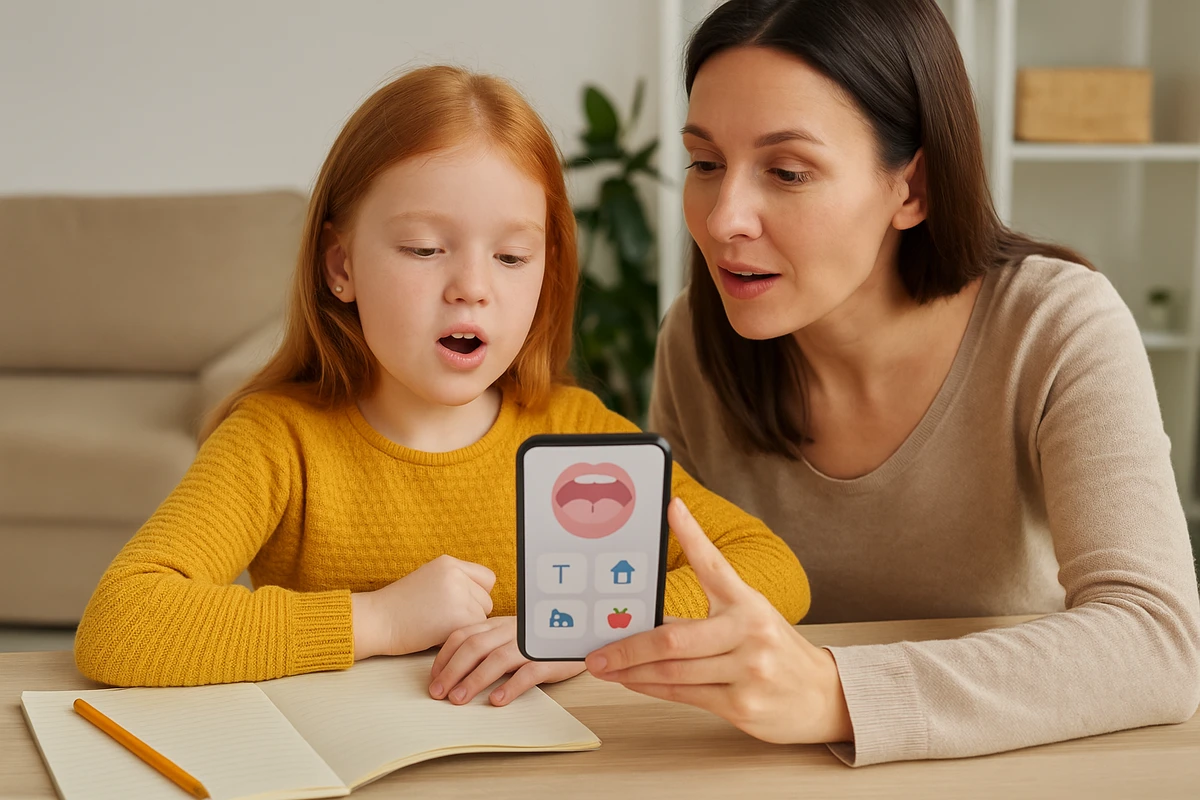Nowadays, parents have to scroll through hundreds of speech therapy apps before finally finding one that actually works. While it feels exciting at first with new tools, bright colors, and hopeful promises, it quickly gets overwhelming.
Every app claims to boost progress, make kids love practice, and turn therapy into a “game.” And some apps really do support speech therapy sessions, while others are just noisy screen time.
That’s why we’re here to help you find your best option. In this guide, you’ll see:
- What good speech therapy apps actually do
- How AI tools are changing at-home practice
- Which speech disorders benefit most from digital tools
- The top-rated apps worth trying
So, let’s make sense of the noise and find what truly helps.
What Are Speech Therapy Apps?
Speech therapy apps are digital tools that help improve speech, language, and communication skills through short, interactive exercises. If you’ve ever practiced speech sounds with flashcards in a clinic, you know it can feel repetitive.
But these apps turn boring drills into games that kids actually want to play (and adults don’t mind using either). You can download them on your phone or tablet and practice anytime, anywhere.
Many of them even have free versions, so you can try them out before paying. Here are the main types of apps you’ll come across.

Apps for Articulation and Pronunciation
These apps help users practice specific sounds through games and systematic review. Speech therapists design them to target tricky sounds and correct common errors. This is how they usually work:
- How It Works: The app shows a picture, the user says the word aloud, and the built-in voice recognition checks how accurate the pronunciation is.
- Focus Sounds: They often focus on sounds like “R,” “S,” and “TH,” since those cause the most trouble.
- Feedback Supports: When the app shows a picture and your child says the word, the technology scores their attempt.
- For Older Kids: Some apps use real photos instead of cartoons, which works better for older kids.
- Difficulty Adjustment: You can adjust difficulty levels as pronunciation improves over time.
So when you get the right app, articulation and pronunciation practice will make the learning process more effective than repeating words blindly.
Language Development Tools
Language apps build vocabulary, grammar, and sentence skills for both children and adults working on communication recovery. For kids, they teach how to form sentences, follow directions, and answer questions through short, interactive tasks.
And for adults recovering from a stroke or brain injury, the exercises often start simple. For example, naming everyday objects, and gradually moving toward building full, meaningful sentences.
Based on our experience of testing these tools, the apps that include real-world scenarios like ordering food or asking for directions get the most useful and effective results.
Gamification and Engagement Features
Even the best exercises fall flat if users lose interest. That’s why top-rated speech therapy apps use gamification to keep people motivated. Users can earn rewards like stickers, new characters, or unlocked levels for consistent practice, and dashboards show clear improvement over time.
Parents often say their children start asking to practice once they can see how much they’ve improved. That sense of achievement, and a little fun competition, keeps everyone engaged and motivated.
How Do AI Features Change Speech Language Therapy?
Speech apps today have come a long way from the old flashcard approach. They can now listen to your voice, notice where you struggle, and adjust the practice to help you improve faster. That way, it feels more like having a patient coach who listens carefully every time, rather than just an app.
- Instant Feedback: When you say a word, the app can tell you what needs work right away. Maybe a sound was missing, or your tongue placement was off. That way, children can improve faster when they can fix small errors immediately.
- Personalized Drills: Instead of repeating random drills, the app pays attention to how you’re doing and makes small adjustments as you go. If you’re already good with one sound, it moves you on to tougher ones. Parents often mention that kids stay more motivated this way because the tasks feel just right for their level of skill.
- Clear Progress Tracking: Each session is recorded so you can see how far you’ve come. Speech therapists find this information helpful because they can review practice results before appointments.
Smart speech apps make the overall progress much more efficient and effective, because people can see their growth and get the right help at the right moment.
What Types of Speech Disorders Benefit Most?
Speech therapy apps usually work best for apraxia, stuttering, and aphasia. Not every condition responds equally, but these three see the biggest gains. Here are a few details about how apps help where repetition, feedback, and daily practice matter most with these speech sound disorders:

- Apraxia and Motor Planning: For kids with apraxia, the brain knows what to say, but the mouth struggles to follow. That’s why the apps let children repeat sounds as many times as needed without frustration. Over time, that repetition helps the brain and mouth sync up.
- Stuttering and Fluency: People who stutter often feel more relaxed when practicing alone. Speech apps create a calm space to work on breathing, pacing, and smooth speech patterns. The software records your voice and helps you notice where stumbles happen most, like on certain letters or longer sentences.
- Aphasia Recovery: For stroke survivors, speech apps start small with exercises like naming objects, and then move toward full sentences as speech returns. Regular practice, even just 20 minutes daily, helps words come back faster and keeps the recovery consistent.
So if you or your child deals with one of these disorders, apps can make a real difference in your recovery timeline.
Which Mobile Apps Lead the Market in 2026?
There are hundreds of speech therapy apps flooding the market. So picking the right one can feel like a maze. That’s why we’ve tested dozens of speech therapy apps, and three consistently outperform the rest for their smart features and easy-to-use designs.
They aren’t free, but their effectiveness makes them worth it. These are the three we recommend:
- Articulation Station Hive: This app covers over 1,200 words and 22 speech sounds using real photos instead of cartoons for age-appropriate learning. Therapists also love it because they can track progress from anywhere. This is a one-time purchase, and it gives you lifetime access to the full version.
- Speech Blubs: On this app, kids learn by watching peers pronounce words correctly. There are also fun face filters that keep practice playful and make the kids want to come back daily. And the parents get weekly updates showing how vocabulary and speech improve.
- Tactus Therapy Suite: Designed for adults recovering from strokes or aphasia, this suite has professional-level exercises and assessment tools. Even therapists use it during sessions, and it helps patients regain language skills faster than typical brain games.
Take a look at this comparison table so you can see more details at a glance:
| Feature | Articulation Station Hive | Speech Blubs | Tactus Therapy Suite |
| Target Users | Children with speech sound issues | Young children who need engaging speech practice | Adults recovering from stroke or aphasia |
| Focus Area | Over 1,200 words, 22 speech sounds | Peer video modeling for pronunciation and vocabulary | Language skills: naming, comprehension, sentence building |
| Visual Style | Real photos, age-appropriate | Fun face filters, kid-friendly videos | Professional, clinical-grade tools |
| Progress Tracking | Tracks client progress, accessible by therapists | Weekly parent reports on vocabulary and articulation | Detailed assessments for therapists to monitor progress |
| Therapist Use | Widely used by speech therapists | Mainly home use with parental involvement | Used during therapy sessions by speech-language pathologists |
| Pricing | One-time payment, lifetime access | Subscription-based, free trial available | Higher-priced, premium clinical tool |
| Unique Feature | Covers almost every speech sound with real images | Encourages practice through peer video modeling & filters | Assessment tools for personalized treatment plans |
These three apps have proven themselves in both therapy and everyday practice. Choosing the right one depends on your needs, but any of these will give you solid support on your speech journey.
Language Therapy Apps That Deserve a Mention
Beyond the big players, there are plenty of smaller apps that handle specific needs really well. These often show up in speech therapist blogs, stroke recovery groups, and AAC forums. So, if you need something more focused, these apps are worth trying.
Core Articulation and Language Apps for Kids
These apps help kids work on their speech and basic language skills through fun and engaging activities. They’re great for building strong foundations in communication early on. For instance,
- Erik X. Raj Articulation Apps: It has fun tasks that keep older kids engaged while working on tricky sounds. One mom told us her son finally practiced his “r” sounds just to finish a “tongue twister dare.”
- Little Stories (Little Bee Speech): This app combines sound practice with early reading and comprehension. Teachers say it helps kids stay focused longer because it feels like storytime, not therapy.
- Reach Speech: This one helps with gradual sound levels that follow natural speech development. Kids start slow at first, but slowly they begin reading short phrases out loud with confidence.
- Otsimo Speech Therapy: Perfect for children with developmental delays. Its bright visuals and simple listening prompts make practice less intimidating and more playful.
- ABCYa: This one feels like school but fun. It has mini games that teach comparing, describing, and explaining without kids even realizing they’re learning language structure.

These apps are great for helping kids stay engaged longer, build confidence faster, and start using clearer speech in real conversations.
Storytelling, Creativity, and Expressive Language
Apps in this category encourage kids to practice language by creating stories and exploring their imagination. They turn learning into play and help the kids express themselves more clearly. Here are some of them:
- ChatterPix Kids: This app lets kids make anything talk, perfect for fun with articulation and storytelling. Teachers love to use it to help shy kids open up.
- Toontastic 3D: Kids become mini directors with this one. They create animated stories, practicing grammar and sequencing along the way.
- Toca Boca Apps: It has open-ended play that naturally sparks language about everyday actions and roles. Speech therapists told us they use Toca Kitchen to help kids practice phrases like “I want,” “too hot,” or “try again.”
Story-based apps make language learning fun and personal. Along with teaching kids to say words, they encourage them to tell stories and share ideas.
AAC and Everyday Communication Support
This category of apps gives a voice to those who struggle with speech, offering customizable boards and ready-made phrases for daily use. The best five are:
- CoughDrop: Families can edit AAC boards from multiple devices with this app. It’s a lifesaver when teachers and parents want consistent communication at school and home.
- Proloquo2Go: This one is used by both children and adults. It turns symbols into quick, clear speech. One parent said it was the first time her son “ordered his own ice cream.”
- Lingraphica SmallTalk: Its specialty is ready-made phrases and videos to support aphasia communication. It’s great for everyday situations like greeting someone or asking for help.
- Tactus Conversation Therapy: This one has guided prompts for real-world conversations with teens and adults. We suggest this for building confidence.
- Constant Therapy: This app mixes language and cognitive exercises for stroke and brain injury recovery. Users love tracking small improvements like remembering names or forming sentences again.
If you need more options for trying things out, then you can start with these apps based on your specific needs. One of them might be the perfect fit for your speech therapy journey.
How Should You Choose a Speech Therapy App in 2026?
When choosing a speech therapy app, start by picking one that’s designed for your particular speech challenge, like apraxia, stuttering, or aphasia. You can also look for recommendations from qualified speech therapists rather than just online reviews or influencers.
Then try out the free version for a week to see if it’s easy to use and helps you make steady progress. If the app keeps you engaged and supports your therapy, you’re on the right path.
But remember that while apps can be a great tool, they can’t replace a real speech therapy program. The best speech therapy apps mostly help you show up again tomorrow, which is exactly what you need for visible improvement.
